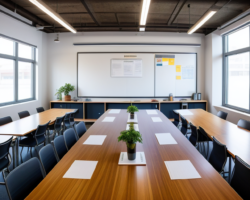Welcome to our latest blog post on workshop safety! Whether you’re a seasoned DIY enthusiast or a professional tradesperson, it’s crucial to prioritize safety when working with tools in the workshop. In this comprehensive guide, we’ll explore the various aspects of workshop safety and provide you with practical tips to ensure your well-being and the well-being of those around you. From understanding the importance of workshop safety to identifying potential hazards, using personal protective equipment (PPE) correctly, and maintaining safe handling and operation techniques, we’ve got you covered. Additionally, we’ll delve into the significance of proper tool selection and maintenance, as well as best practices for preventing workshop accidents. We’ll also discuss emergency preparedness and first aid in the workshop, so you can be well-prepared for any unforeseen circumstances. So, grab a cup of coffee and join us as we embark on this essential journey towards workshop safety!
Understanding the Importance of Workshop Safety
Workshop safety is a critical aspect of any industrial or construction environment. It involves the implementation of proper safety protocols to protect workers from potential hazards and accidents. Understanding the importance of workshop safety is essential for creating a secure working environment.
Employers and employees must prioritize workshop safety to prevent injuries, illnesses, and fatalities. Establishing a safety culture within the workshop ensures that everyone is aware of the potential risks and takes proactive measures to mitigate them.
Training and education on workshop safety equip workers with the knowledge and skills to identify potential hazards and adhere to safety guidelines. It also promotes a sense of responsibility towards their own safety and that of their colleagues.
Furthermore, implementing effective safety measures in the workshop not only protects the workers but also safeguards the equipment, tools, and materials from damage or loss. It contributes to the overall efficiency and productivity of the workshop.
Identifying and Evaluating Potential Hazards
Identifying and evaluating potential hazards in the workshop is crucial for maintaining a safe working environment. It involves a thorough assessment of the workspace to pinpoint any existing or potential dangers that could cause harm to the workers.
Common hazards in a workshop setting include but are not limited to: sharp objects, electrical hazards, slippery floors, falling objects, and exposure to toxic chemicals. By identifying these hazards, workshop managers and workers can take proactive measures to mitigate the risks and prevent accidents.
Evaluating potential hazards requires a systematic approach. It involves conducting regular risk assessments and inspections to identify new hazards or evaluate the effectiveness of existing control measures. This process ensures that the workshop remains up-to-date with safety standards and regulations, ultimately reducing the likelihood of workplace incidents.
Moreover, it is essential to involve the workforce in hazard identification and evaluation. Workers who are directly involved in the day-to-day operations of the workshop often have valuable insights into potential hazards that may not be apparent during a standard inspection. Their input can significantly contribute to the overall safety of the workplace.
Using Personal Protective Equipment (PPE) Correctly
Personal Protective Equipment (PPE) plays a crucial role in ensuring the safety of workers in a workshop environment. It is essential to understand the correct usage of PPE to provide effective protection against potential hazards.
When using PPE, it is important to inspect it for any damage or defects before each use. This includes checking for tears, cracks, or any other forms of damage that could compromise its effectiveness.
Additionally, it is crucial to ensure that the PPE fits properly and comfortably to provide the necessary protection. Proper fitting is essential for the PPE to effectively guard against potential hazards.
Furthermore, it is essential to clean and maintain the PPE regularly to extend its lifespan and ensure its continued effectiveness. This includes following the manufacturer’s instructions for cleaning and storage to prevent any form of degradation that could compromise its protective capabilities.
Proper Tool Selection and Maintenance
Proper tool selection and maintenance are crucial aspects of ensuring workshop safety and efficiency. Selecting the right tool for the job not only improves the quality of work but also reduces the risk of accidents and injuries. It is important to consider factors such as the material being worked on, the specific task at hand, and the user’s experience and skill level when choosing tools.
Maintenance of tools is equally important. Regular inspection, cleaning, and proper storage can extend the lifespan of tools, ensuring that they perform optimally and safely. This includes sharpening blades, replacing worn-out parts, and lubricating moving components. Neglecting tool maintenance can lead to malfunctions, accidents, and costly replacements.
Investing in high-quality tools and adhering to a proactive maintenance routine can save time and money in the long run. It also contributes to a safer and more productive workshop environment.
Proper tool selection and maintenance should be prioritized in any workshop, and it is an essential part of overall workshop safety and efficiency.
Safe Handling and Operation Techniques
When working in a workshop environment, safe handling and operation techniques are crucial for preventing accidents and injuries. One of the most important aspects of safe handling is to always use the correct lifting and carrying techniques when moving heavy objects. This includes bending your knees, keeping the load close to your body, and using the strength of your legs to lift.
Another key aspect of safe handling is to be mindful of your surroundings and the potential hazards that may be present. This means being aware of trip and slip hazards, as well as the location of emergency equipment such as fire extinguishers and first aid kits.
When it comes to safe operation techniques, it is essential to receive proper training on the use of machinery and equipment. This includes understanding the manufacturer’s guidelines, as well as any specific safety precautions that need to be taken.
Finally, when operating machinery or tools, it is important to always wear the appropriate personal protective equipment (PPE) such as gloves, safety goggles, and ear protection. Following these safe handling and operation techniques can greatly reduce the risk of accidents in the workshop.
Preventing Workshop Accidents: Best Practices
Workshop accidents can have serious consequences, including injury or even death. It is crucial for all workshop participants to be aware of the best practices for preventing accidents in the workshop setting. By following safety protocols, being mindful of potential hazards, and taking the necessary precautions, workshop accidents can be minimized or avoided altogether.
One of the best practices for preventing workshop accidents is to maintain a clean and organized work environment. Clutter and disorganization can lead to slips, trips, and falls, so it is important to keep work areas free of debris and obstacles. Additionally, tools and equipment should be stored properly when not in use, and spills should be cleaned up promptly to prevent accidents.
Proper training and education are also essential for preventing workshop accidents. All workshop participants should be familiar with the correct operation of tools and equipment, as well as the appropriate personal protective equipment (PPE) to use for specific tasks. Regular safety training and refresher courses can help ensure that everyone in the workshop is aware of the best practices for accident prevention.
Another crucial aspect of preventing workshop accidents is promoting a culture of safety in the workshop. By encouraging open communication about potential hazards and providing opportunities for workshop participants to report safety concerns, accidents can be proactively addressed and prevented. It is also important for workshop organizers and supervisors to lead by example and prioritize safety in all workshop activities.
Emergency Preparedness and First Aid in the Workshop
In any workshop setting, it is crucial to be prepared for any emergencies that may arise. From minor injuries to major accidents, having a plan in place can make all the difference in ensuring the safety and well-being of everyone involved.
One of the first steps in emergency preparedness is to have a well-stocked first aid kit readily available. This should include items such as bandages, antiseptic ointment, gauze pads, adhesive tape, and any necessary medications for individuals with known medical conditions.
Additionally, all workshop personnel should be trained in basic first aid techniques, such as CPR, treating burns, and recognizing the signs of shock or a heart attack. Regular drills and training sessions can help ensure that everyone is well-prepared to respond in the event of an emergency.
It is also important to have a clear and easily accessible emergency exit plan. This should include designated meeting points for employees to gather after safely exiting the workshop, as well as a system for accounting for all personnel to ensure that everyone has safely evacuated the building.





